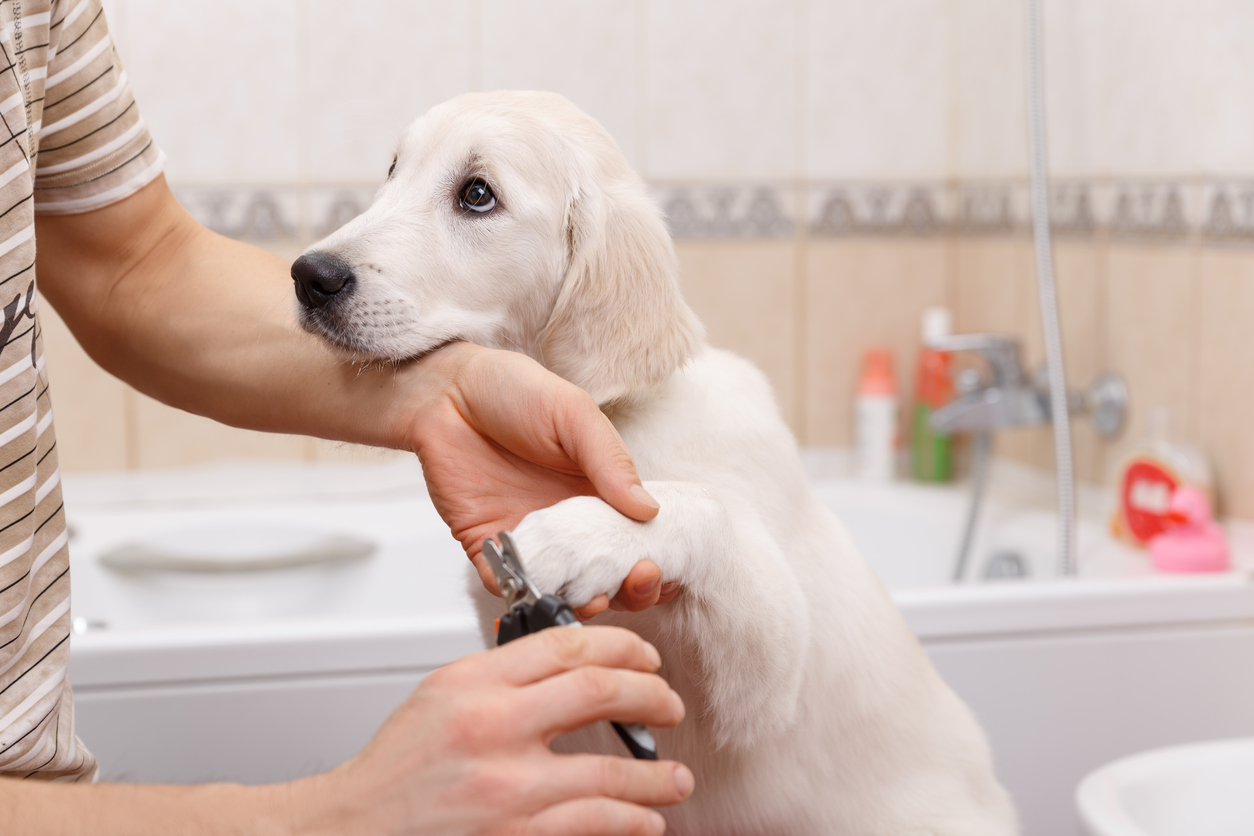
A person with a broken fingernail or toenail may become annoyed, but when a dog breaks a nail, it can be very painful and somewhat dangerous. A dog can break or snag a nail on just about anything: concrete walkways, stairs, carpeting, or even fabrics. Because it can happen at any time, pet owners should be prepared to recognize and treat the condition.
Allowing your dog’s nails to grow long increases his or her chances for breaking a nail. Long nails also alter a dog’s ability to walk comfortably, forcing pressure on the pastern (wrists), which can contribute to sprains and other problems in the feet. Long nails easily snag or tear when a dog is moving. Normal everyday activities can lead dogs with long nails to encounter problems. Walking or running on hard surfaces can break or crack the nail. Twisting during sleep could cause a nail to snag bedding. Running up the stairs could snag the carpet and break a nail.
Nail Trimming
Misty is a prissy little dog. This diminutive poodle mix is loved and pampered. She has a beautiful closet of dresses, bows and coats, and her house is scattered with toys of all shapes and sizes. But Misty is a bit dominant, and she fights her owner when it’s time for a nail trim. She cries, wiggles, and pulls her leg away when Lori gets ready to snip the points off of her toenails. When Misty’s dewclaws (thumb nails) got so long that they were curling toward her skin, Lori got serious and tried to trim, but she ended up breaking the nail.
Hank is a pretty mellow Rottweiler with thick, black nails. His owner Heather once cut a nail too short, and it bled all over them both. Since then Heather has been shy about trimming nails, so Hank usually wears down his nails on concrete, saving her the trauma. But one day Hank broke a long nail when he raced to “greet” a stranger at the door. The nail became infected because Heather never saw through the mud on Hank’s feet.
Keeping the nails short and smooth can prevent problems, as they rarely break. Ironically, nail trimming is also one of the most common causes of broken nails. To avoid issues, make sure you use the right sized tool for your dog’s size, and keep those blades sharpened. If trimming nails is difficult, take your dog to an animal hospital or grooming shop to have the deed done.
Recognizing a Damaged Nail
A dog may not immediately respond to a broken nail, but as swelling or infection occur, you may notice that he or she licks at the toes, favors one leg, limps, or avoids movement. A broken nail could also leave blood on your floors or in your dog’s bedding. Severe bleeding or intense pain indicates that the dog should be seen by a veterinarian, but minor breaks and tears can be treated at home.
Treating at Home
Your dog may snap at you when you when you attempt to examine his or her foot, so you may need to use a muzzle for examination and treatment. An assistant can be helpful with these procedures:
1. Remove any dangling pieces of the nail, or clip back the broken area.
2. Stop bleeding using a styptic pencil or quick stop powder. You can also use cornstarch, and apply gentle pressure with a gauze pad.
3. Clean the toe area and the foot. Check for discharge or swelling. Take your dog to the veterinarian immediately if you detect pus or extreme sensitivity.
4. Wrap the paw with bandage materials, but don’t be surprised if your dog tries to pull it off.
5. Crate your dog to keep him or her immobile until the wound heals, and carry him or her outside for toileting.
Most dogs recover from broken toenails quickly and return to normal activity. Discuss any concerns with your dog’s veterinarian at your next checkup.
 A person with a broken fingernail or toenail may become annoyed, but when a dog breaks a nail, it can be very painful and somewhat dangerous. A dog can break or snag a nail on just about anything: concrete walkways, stairs, carpeting, or even fabrics. Because it can happen at any time, pet owners should be prepared to recognize and treat the condition.
Allowing your dog’s nails to grow long increases his or her chances for breaking a nail. Long nails also alter a dog’s ability to walk comfortably, forcing pressure on the pastern (wrists), which can contribute to sprains and other problems in the feet. Long nails easily snag or tear when a dog is moving. Normal everyday activities can lead dogs with long nails to encounter problems. Walking or running on hard surfaces can break or crack the nail. Twisting during sleep could cause a nail to snag bedding. Running up the stairs could snag the carpet and break a nail.
Nail Trimming
Misty is a prissy little dog. This diminutive poodle mix is loved and pampered. She has a beautiful closet of dresses, bows and coats, and her house is scattered with toys of all shapes and sizes. But Misty is a bit dominant, and she fights her owner when it’s time for a nail trim. She cries, wiggles, and pulls her leg away when Lori gets ready to snip the points off of her toenails. When Misty’s dewclaws (thumb nails) got so long that they were curling toward her skin, Lori got serious and tried to trim, but she ended up breaking the nail.
Hank is a pretty mellow Rottweiler with thick, black nails. His owner Heather once cut a nail too short, and it bled all over them both. Since then Heather has been shy about trimming nails, so Hank usually wears down his nails on concrete, saving her the trauma. But one day Hank broke a long nail when he raced to “greet” a stranger at the door. The nail became infected because Heather never saw through the mud on Hank’s feet.
Keeping the nails short and smooth can prevent problems, as they rarely break. Ironically, nail trimming is also one of the most common causes of broken nails. To avoid issues, make sure you use the right sized tool for your dog’s size, and keep those blades sharpened. If trimming nails is difficult, take your dog to an animal hospital or grooming shop to have the deed done.
Recognizing a Damaged Nail
A dog may not immediately respond to a broken nail, but as swelling or infection occur, you may notice that he or she licks at the toes, favors one leg, limps, or avoids movement. A broken nail could also leave blood on your floors or in your dog’s bedding. Severe bleeding or intense pain indicates that the dog should be seen by a veterinarian, but minor breaks and tears can be treated at home.
Treating at Home
Your dog may snap at you when you when you attempt to examine his or her foot, so you may need to use a muzzle for examination and treatment. An assistant can be helpful with these procedures:
1. Remove any dangling pieces of the nail, or clip back the broken area.
2. Stop bleeding using a styptic pencil or quick stop powder. You can also use cornstarch, and apply gentle pressure with a gauze pad.
3. Clean the toe area and the foot. Check for discharge or swelling. Take your dog to the veterinarian immediately if you detect pus or extreme sensitivity.
4. Wrap the paw with bandage materials, but don’t be surprised if your dog tries to pull it off.
5. Crate your dog to keep him or her immobile until the wound heals, and carry him or her outside for toileting.
Most dogs recover from broken toenails quickly and return to normal activity. Discuss any concerns with your dog’s veterinarian at your next checkup.
A person with a broken fingernail or toenail may become annoyed, but when a dog breaks a nail, it can be very painful and somewhat dangerous. A dog can break or snag a nail on just about anything: concrete walkways, stairs, carpeting, or even fabrics. Because it can happen at any time, pet owners should be prepared to recognize and treat the condition.
Allowing your dog’s nails to grow long increases his or her chances for breaking a nail. Long nails also alter a dog’s ability to walk comfortably, forcing pressure on the pastern (wrists), which can contribute to sprains and other problems in the feet. Long nails easily snag or tear when a dog is moving. Normal everyday activities can lead dogs with long nails to encounter problems. Walking or running on hard surfaces can break or crack the nail. Twisting during sleep could cause a nail to snag bedding. Running up the stairs could snag the carpet and break a nail.
Nail Trimming
Misty is a prissy little dog. This diminutive poodle mix is loved and pampered. She has a beautiful closet of dresses, bows and coats, and her house is scattered with toys of all shapes and sizes. But Misty is a bit dominant, and she fights her owner when it’s time for a nail trim. She cries, wiggles, and pulls her leg away when Lori gets ready to snip the points off of her toenails. When Misty’s dewclaws (thumb nails) got so long that they were curling toward her skin, Lori got serious and tried to trim, but she ended up breaking the nail.
Hank is a pretty mellow Rottweiler with thick, black nails. His owner Heather once cut a nail too short, and it bled all over them both. Since then Heather has been shy about trimming nails, so Hank usually wears down his nails on concrete, saving her the trauma. But one day Hank broke a long nail when he raced to “greet” a stranger at the door. The nail became infected because Heather never saw through the mud on Hank’s feet.
Keeping the nails short and smooth can prevent problems, as they rarely break. Ironically, nail trimming is also one of the most common causes of broken nails. To avoid issues, make sure you use the right sized tool for your dog’s size, and keep those blades sharpened. If trimming nails is difficult, take your dog to an animal hospital or grooming shop to have the deed done.
Recognizing a Damaged Nail
A dog may not immediately respond to a broken nail, but as swelling or infection occur, you may notice that he or she licks at the toes, favors one leg, limps, or avoids movement. A broken nail could also leave blood on your floors or in your dog’s bedding. Severe bleeding or intense pain indicates that the dog should be seen by a veterinarian, but minor breaks and tears can be treated at home.
Treating at Home
Your dog may snap at you when you when you attempt to examine his or her foot, so you may need to use a muzzle for examination and treatment. An assistant can be helpful with these procedures:
1. Remove any dangling pieces of the nail, or clip back the broken area.
2. Stop bleeding using a styptic pencil or quick stop powder. You can also use cornstarch, and apply gentle pressure with a gauze pad.
3. Clean the toe area and the foot. Check for discharge or swelling. Take your dog to the veterinarian immediately if you detect pus or extreme sensitivity.
4. Wrap the paw with bandage materials, but don’t be surprised if your dog tries to pull it off.
5. Crate your dog to keep him or her immobile until the wound heals, and carry him or her outside for toileting.
Most dogs recover from broken toenails quickly and return to normal activity. Discuss any concerns with your dog’s veterinarian at your next checkup.
